Often mistaken with the Prayer plant for the variegated patterns in the foliage, Calathea appears to have “eyes” on the leaves, with more varieties upholding the same feature.
If adding Calathea to your plant collection is on your bucket list, continue reading to know its best varieties.
Table of Contents Show
20 Calathea Varieties with Names & Pictures
Calathea had more than 250 species, but many were added to the new genus Goeppertia, leaving the plant with 60 species and 70 varieties.
As the plant grows, it can reach up to about 3 feet or higher, but remember it is a slow grower, making a great floor plant or a low plant stand.
Before extending more, know the list and decide which best suits your space.
1. Freddie Calathea
Also known as Calathea concinna, Freddie Calathea is native to the tropical rainforests of Rio De Janeiro, Brazil.
The Calathea can get about 2-3 feet tall if it grows indoors with its elongated oval, dark green pointed leaves growing in alternate patterns around its stem.
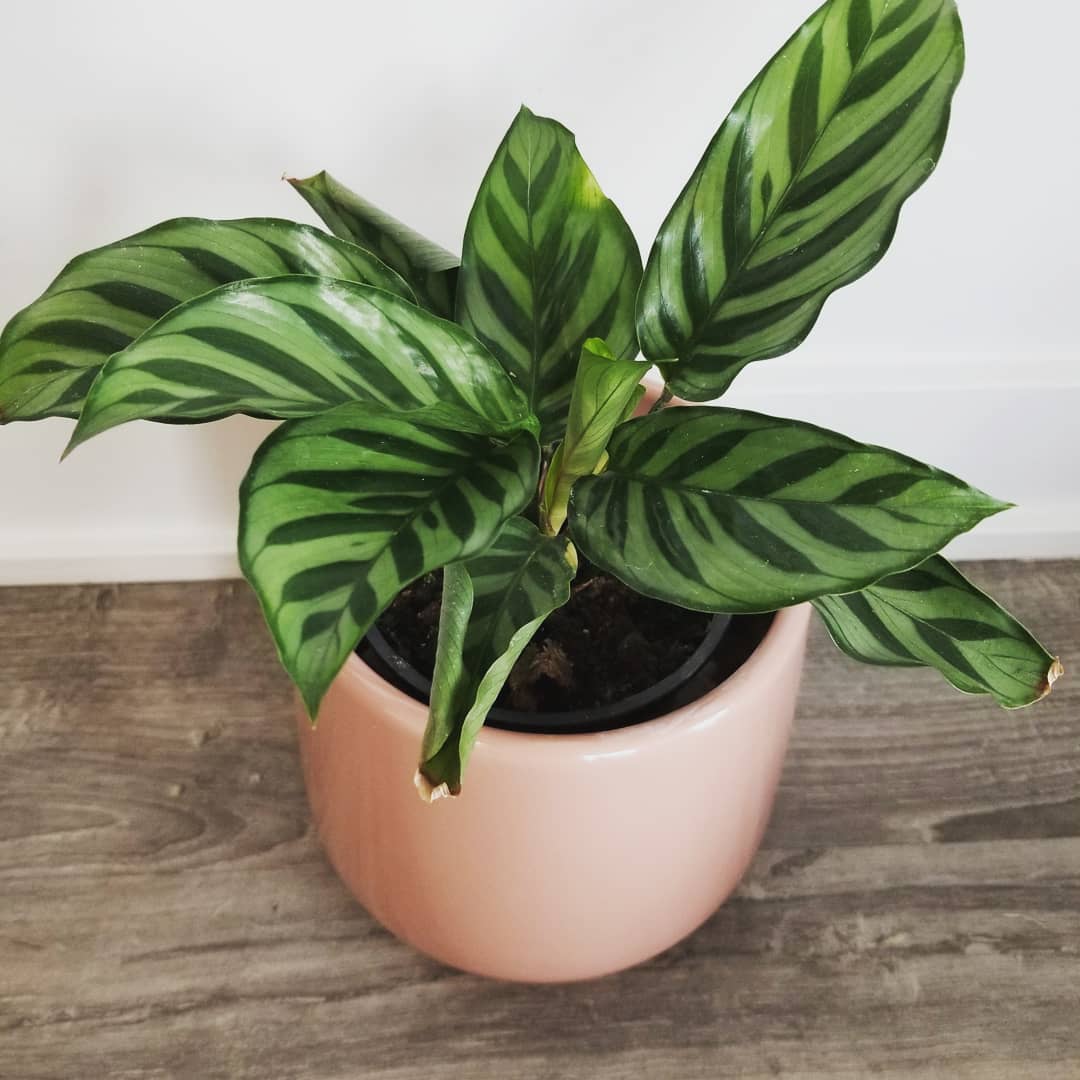
The leaves boast a pale and greenish-white feathery pattern running along with the mid-veining of each leaf that can reach around 4-7 inches long.
Also known as the Zebra plant, the Calathea Freddie gives white flowers, each blooming on the long stalk-like inflorescence from the center of the plant’s base.
2. Calathea Lancifolia
Another Calathea species is Calathea lancifolia, which commonly represents the Rattlesnake plant, a native to the Brazilian rainforest.
Like all Calathea, Calathea lancifolia boasts a pattern that resembles the markings found on some Rattlesnakes and grows between 24 and 30 inches when it gets proper care.

Besides, Calathea lancifolia contains slender green-bladed leaves shaped like a lance or spearhead.
These leaves contain dark green leaf-like patterns rotating along each side of the leaf’s center and can reach up to 18 inches long if measured.
Also, this variety is a flowering perennial that blooms with 2-4 inches long conical spikes during late spring to early summer.
3. Corona Calathea
Don’t fear its name, as Corona calathea won’t harm you. Being native to Brazil, Corona Calathea can reach about 12 inches tall and 9-12 inches wide.
Also, the foliage features silvery-green leaves that taper to a point and are edged with a broad band of dark green held by a reddish-purple stem.
Moreover, each leaf has a unique midrib, even reddish in hue.
The tropical variety also produces white and purple flowers from green bracts during spring.
4. Calathea Zebrina
Calathea zebrina is also called a Zebra Plant because its leaves have the same pattern as the Zebra and are native to Southeastern Brazil.
The plant is moderately fast-growing, so you can expect it to reach around 80cm to 1-meter height with long stalks.
Meanwhile, the other side of the leaves is reddish-purple, and each leaf can reach up to 12 inches or longer.
The plant also blooms with large, low-growing inflorescences with white and purple flowers.
5. Calathea Makoyana
Another name for Calathea makoyana is a peacock plant because its foliage resembles a peacock’s tail.
Native to eastern Brazil, this small Calathea grows 1-2 feet tall, has deep green oval leaves and owns foliage with purplish-pink lines underneath.

These light green leaves, which can grow 10 to 12 inches long, give a feathery appearance due to the dark green center and margin.
Besides, Calathea makoyana has a sizeable red stem that holds the leaf from the edge.
You can also witness purple and white flowers which bloom in tiny flower clusters on the ends of stems between the large leaves.
6. Calathea Ornata
Native to South America, Calathea ornata is commonly known as Pinstripe Plant due to the pin-like stripes in its leaves.
Meanwhile, this Calathea plant can grow up to 3-9 feet in size in the wild and 3 feet wide by 3 feet tall when grown indoors.
If you want a flower, Calathea ornata can never let you down as it gives oval-shaped orange blooms that grow from twisted green bracts.
7. Calathea Orbifolia
Calathea orbifolia is another variety native to Bolivia that is a moderate to fast, grower. You can expect it to reach 1m in height and width.
Boasting its foliage, Calathea orbifolia has one of the largest leaves among the varieties that can even reach 1 foot in length, offering rounded oval leaves.
In the springtime, they bloom and produce clusters of small white star-shaped flowers in their natural habitat. These rare flowers can measure white flowers 2 inches long.
8. Calathea Crocata
Calathea crocata is also known as “the Eternal Flame” due to its spiky yellow blooms resembling little flames.
It is native to Brazil and, as a result, grows healthiest in a humid environment.
The plant produces yellow and orange flowers that develop on the top of the stems, a bit higher than the leaves, with blossoms lasting for three months.
Calathea crocata can grow anywhere between 1 to 2 feet if adequately cared for.
9. Calathea Triostar
Calathea triostar is named a “Triostar” because of its three-colored foliage.
Native to the tropical regions of Costa Rica, the plant can grow 2 to 3 feet in height and 1 to 2 feet in width.
Calathea triostar can make a great statement piece in your home with its stunning variegated leaves in shades of pink, green and white, with red undersides.
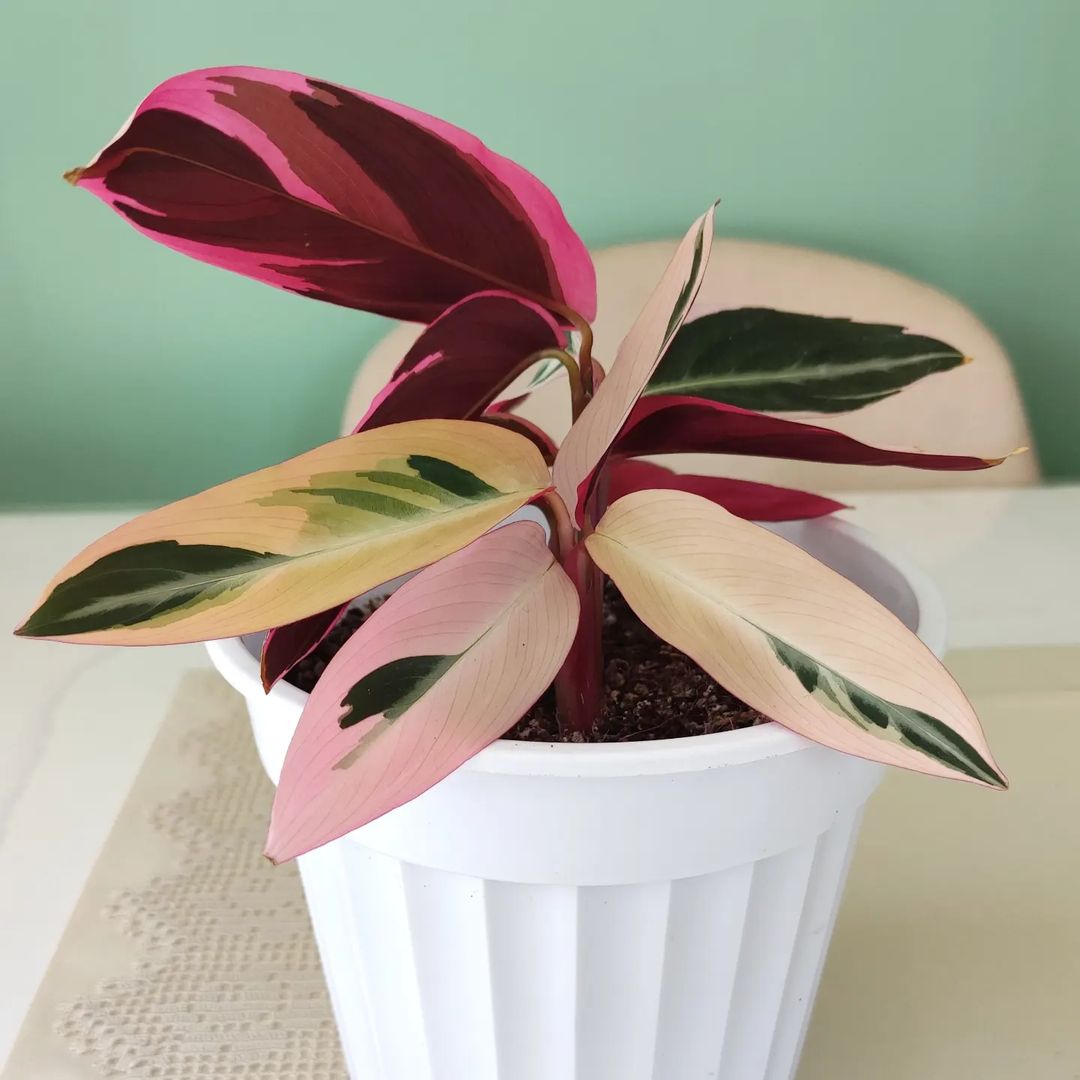
Each leaf has unique work of art with pink, cream, and shades of green lasciviously splashed along spear-like leaves.
Triostars also produce flowers in March and April that appears above the foliage in loose clusters.
These flowers open as orange-red buds and end with a cherry pink in maturity.
10. Calathea Warscewiczii
Native to Central America, Calathe warscewiczii can grow to 3-4 feet high and wide if offered good care.
Calathea warscewiczii has velvety leaves with fishtail patterns having both light and dark green tones on the upperside with burgundy undersides.
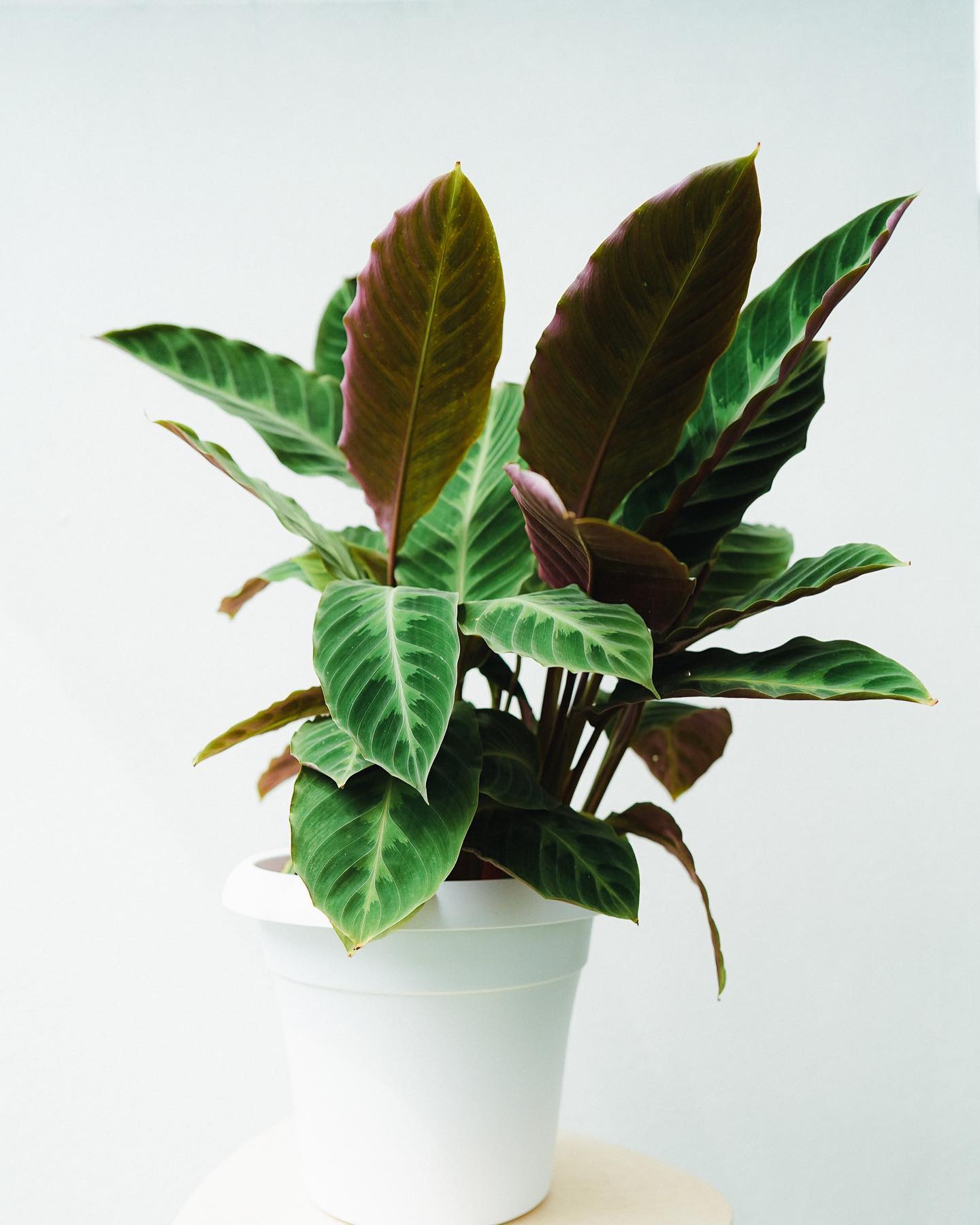
In addition, this variety of Calathea blooms in white flowers in late winter and early spring.
The flower bracts appear on tall spikes, with white petals emerging from the cone’s interior, and can last only up to a month.
11. Calathea Majestica
Calathea majestica is a herbaceous evergreen perennial that grows to give a single leaf of about 3 feet with an erect and spreading form.
Leaves of Calathea majestica are big and oblong, with white stripes running from the center to the borders.
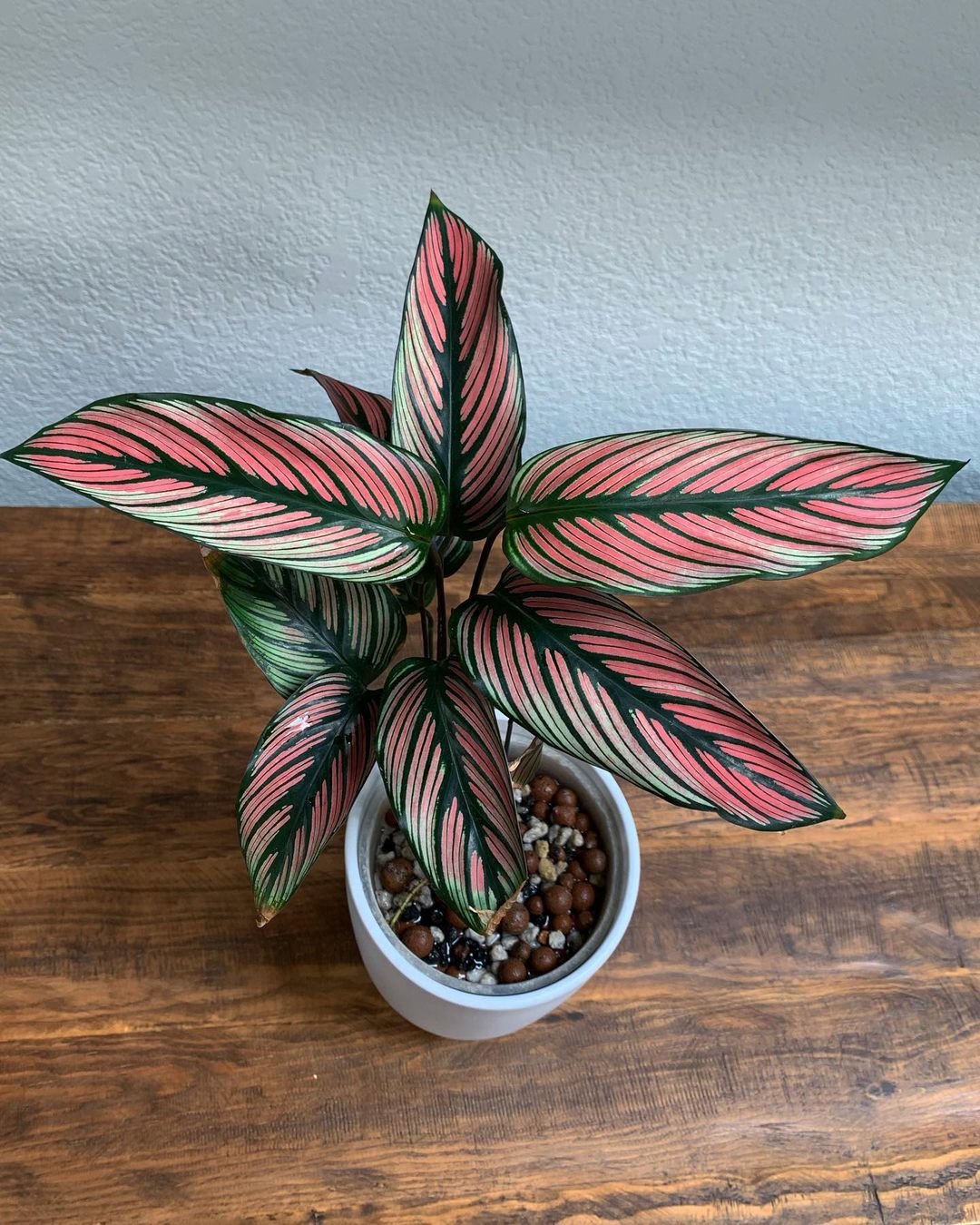
You can notice patches of soft pink on top of their white stripe leaves, with vivid red on the undersides of mature plants.
Besides, it thrives in USDA zone 11 through 12 and can grow between 4 to 5 feet which is great for placing in the corner of your room.
It rarely blooms, and when it does flower, it remains small and inconspicuous, making it famous for its lush foliage.
12. Calathea Rufibarba
Calathea rufibarba is usually known by its other name, Furry Feather, because of its fur-like texture on the undersides of the leaves.
Native to Brazil, this plant can grow 3.5 feet tall and about 2 feet wide with a growth rate of 1-2 feet yearly but slows down in later years.
Interestingly, Calathea rufibarba has red stems and semi-glossy spear-like foliage that is very long green on top, making it one of the tall varieties.

The foliage feature of Rufibarba is elongated, wavy green young leaves with a crimson-purple underside, reaching a foot long.
This Calathea produces a yellow flower that can last about 1-3 months when it matures but rarely blooms indoors.
13. Calathea Elliptica
Calathea elliptica is also known as Calathea ‘Vittata’ and is considered an ornate plant.
Native to Colombia and French Guiana, Calathea elliptica can have a height of up to 2 feet.
The leaves can reach 18″ in length to create a marbled appearance.
Also, Calathea elliptica has a small, densely vibrant green bracted spike that emerges from a stalk within the leaves to give out the pale cream flowers.
14. Calathea Gymnocarpa
Native to Nicaragua and Colombia, Calathea gymnocarpa is also called Goeppertia gymnocarpa.
Calathea gymnocarpa has long and dark green leaves with a striped texture and contains somewhat wavy edges.
It is hard for gymnocarpa to bloom indoors, but it offers orange and white flowers in the wild.
15. Calathea Lietzei
Also known as White Fusion, Calathea lietzei is considered the rarest Calathea and is native to Central Mexico and tropical South America.
This Calathea reaches around 60cm, so you can easily position it anywhere indoors.
It offers clumps of long, narrow, lance-shaped, and variegated leaves with purple undersides, and each leaf measures up to 45cm in length.
Moreover, the plant does bloom indoors, under suitable lighting conditions, but you can witness bract with white flowers coming from the stalk if grown in the wild.
16. Calathea Dottie
Calathea Roseopicta ‘Dottie’ is a commercially cultivated houseplant famous for its dark green burgundy foliage in a rosette pattern.
Though the plant is native to Brazil, you cannot find it in the wild, which can make it unique in the Calathea varieties.
With a thriving habit of USDA zone 10b to 12, Calathea dottie can reach a height of around 40cm to 60cm.
It is also notable for the plant to witness little white blooms during summer, but flowers will appear only on rare occasions when kept as an indoor plant.
17. Calathea Fasciata
Native to the northeast of Brazil and the USDA zone (11 to 12), the Calathea fasciata extends anywhere between 20 cm and 65 cm.
Like other Calathea, Fasciata boasts foliage that features thick and luscious leaves with dark and light veins on the top and gorgeous purple undersides.
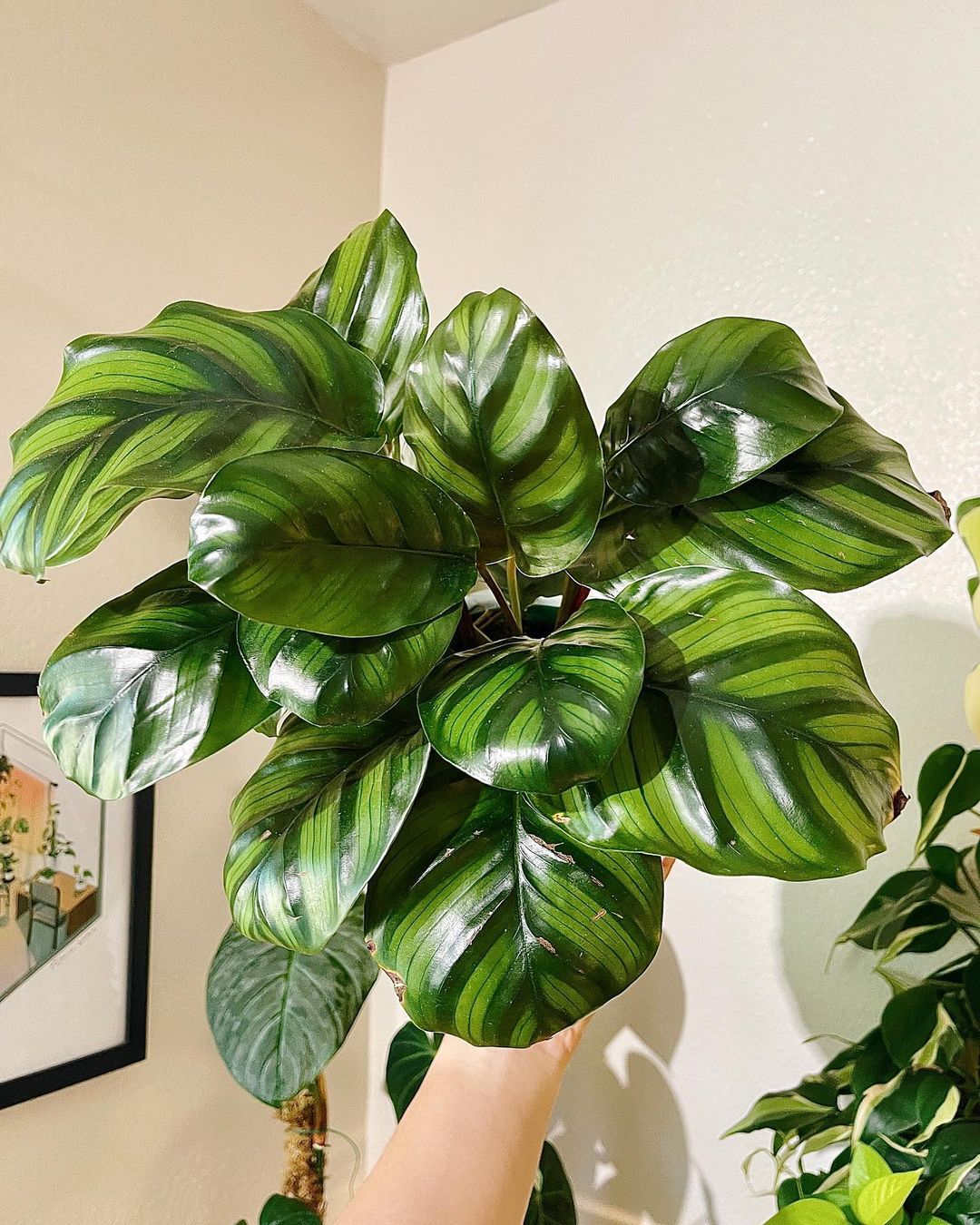
And each leaf is measured around 5 to 6 cm in length and 5 cm in width when the foliage matures.
Calathea fasciata thrives by a noninvasive creeping rhizome, so you need not worry about your pets roaming around it.
18. Calathea Ecuadoriana
As the name suggests, Calathea ecuadoriana is native to Ecuador of South America and prospers in USDA zone 9-12.
It is an evergreen, clump-forming perennial herb that can grow to 40-50 cm tall with a creeping rhizome.
The foliage of Calathea ecuadoriana features the top part of the leaf as olive green with lighter veins, whereas the underside is purple to dark crimson.

If you want to see flowers of Goeppertia ecuadoriana, you need to be lucky enough as they bloom in summer but rarely in cultivation.
The plant produces the racemes of tubular flowers with light green bracts, but these yellow flowers are insignificant and lack fragrance.
19. Calathea Crotalifera
Calathea crotalifera is also known as the Rattle Snake plant because of its inflorescences that resemble a baby rattle.
Native to Central America, Mexico, and South America, it prospers in USDA zone 10-12 and can grow up to 10 feet tall.
The topsides of the leaves are dark green, while a mix of gray and green covers the undersides.
Moreover, the plant is famous for its bloom, with peculiar yellow upright inflorescences mimicking rattlesnakes extending up to 10 inches long.
When the flowers mature, they bear about 1.3 cm long, egg-shaped seed capsules with dark blue seeds inside a white flesh.
20. Calathea Macrosepala
Native to southern Mexico, western Colombia, and Trinidad, the plant can grow anywhere between 0.6 and 1.8 m in height.
With its striking beauty, Calathea macrosepala features large basal leaves with pointed apex, green feather-like patterns along the central vein, and pale green on the underside.

Likewise, the blooms of this Calathea are oval to spherical, 1.5-4 inches long and 1-2 inches broad, with persistent, upright petals.
The flower of Calathea macrosepala is edible and can be used in various recipes like soups and salads worldwide.
Some More Varieties of Calathea
The long list of Calathea does not end here. There are other beautiful varieties you must not miss.
| Calathea Varieites | Growth Sizes | Features |
|---|---|---|
| Calathea lutea | Length:13 feet tall Wide: 8-12 inches | Leathery leaves with creamy and light-green stripes |
| Calathea musaica | Length: 2 feet tall Wide: 2 to 3 feet | Oval light green foliage with mosaic-like markings |
| Calathea marantifolia | Length: 1-2 feet tall Width: 1-2 feet | Leaves resemble banana leaves with broad and thin-stemmed leaves |
| Calathea lasiostachya | Length: 2-3 feet Width: 1.5 feet | Leaves are long, slender, and tough |
| Calathea albertii | Length: 0.8-1.3 feet Width: 1 feet | Leaves are shiny, dark green with pale green stripes and red on the undersides |
| Calathea variegata | Length: 2-3 feet Width: 2 feet | Long light green leaves with dark green stripes |
| Calathea picturata | Length: 1.3- 2 feet Width: 3 feet | The leaves have a green band around the perimeter of the leaf with a pale green interior |
| Calathea wiotii | Length: 6 inches Width: 1-2 feet | Light green leaves with dark green stripes |
| Calathea ‘Helen Kennedy’ | Length: 2-3 feet Width: 1.5 feet | The foliage looks like a peacock with a pale green and dark green contrast |
| Calathea 'Pink Aurora' | Length: 2 feet Width: 1.5 feet | Pale green leaves with a thin dark green band on the perimeter |
Tips To Care for Calathea Plants
Calathea plants are tender perennials that grow in clumps from tuberous and underground roots.
Keep the following requirements to grow your Calathea to the best version.
- Calathea needs 8 to 10 hours of medium indirect sunlight. Alternatively, you can use grow light and keep the plant under it for at least 12 hours.
- Water the Calathea weekly using tap, filtered, or distilled water during summer.
- Also, Calathea best thrives in a loamy soil mix that drains well but remains damp and is slightly acidic (pH 6.5).
- Alternatively, mix 40% coco coir, 40% perlite, and 20% potting soil to prepare one yourself.
- Set the temperature between 65 and 85ºF and the humidity level around 60%.
- You can cater to Calathea varieties with a balanced or all-purpose fertilizer (10-10-10) monthly during spring and summer.
- Try repotting the Calathea once every 1-2 years with the pot 1-2 inches bigger than the previous one.
- You need not bother Calathea to prune, but you can do it occasionally if it grows fully.
- If you find the pests such as Spider Mites, Whiteflies, Scales, Mealybugs, or Thrips, apply neem oil, horticultural oil, insecticidal soap, or sticky traps to control them.
- Bacterial Leaf Spots and Root Rot also trouble these plants, so you need to treat them in time.
From Editorial Team
Conclusion!
Displaying these Calathea varieties will make a statement in your house and brighten your space.
Besides, these plants can purify the air, boost humidity levels, trap dust and are pet-friendly, so care for them until the end to enjoy a gardener life.


